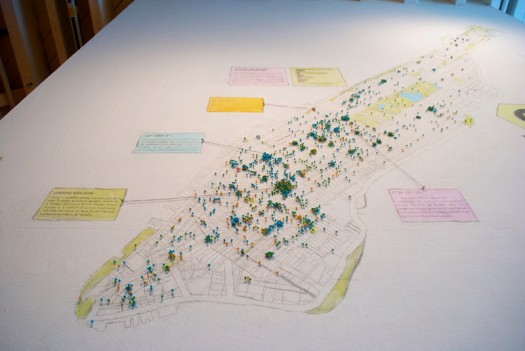
Celebrate ten years of Urban Omnibus and support ten more years of fresh, independent perspectives on citymaking with a donation today!
Celebrate ten years of Urban Omnibus and support ten more years of fresh, independent perspectives on citymaking with a donation today!
You Are Here → Mapping the Psychogeography of New York City, an exhibit now on view at the Pratt Institute’s Manhattan Gallery, is guest curated by Katharine Harmon, owner of Tributary Books in Seattle and author of the cartography-inclined books Map as Art (2009) and You Are Here (2003). Her published compilations of maps and data visualizations are thought-provoking and emotional expressions of place, an approach echoed in the exhibition’s stated objective to “map the emotional terrain of the world’s most famous and influential urban center, New York City, and explore the effect of the city’s powerful moods on those who live and work here.” Though the works range from lighthearted to somber, there is a pervading sense of humor and playfulness throughout much of the show.
Harmon takes full advantage of the three-dimensional world with the introduction of sensory perceptions not available for use in book format. Scratch ‘N Sniff NYC by Nicola Twilley maps New Yorkers’ smell preferences and perceptions (both shared and individual – one map documents the most common perceptions by neighborhood, another will be filled in over the course of the exhibition by visitor participation). Nina Katchadourian’s New York Soundtrack offers an audio portrait of the city through a collection of found cassette tape. Daniela Kostova and Olivia Robinson’s Anxiety Map of unemployment rates is lit by sweat-powered batteries. More than just a venue for viewing, smelling and listening, the show also encourages a spirit of joy, with people jumping up and down trying to get Liz Hickok‘s Jell-O model of New York City to jiggle.
Psychogeography, as defined in the 1958 Internationale Situationniste #1, is “the study of the precise effects of geographical setting, consciously managed or not, acting directly on the mood and behaviour of the individual.” The Loneliness Map by Ingrid Burrington is a precise example of psychogeography, mapping out the missed connections of lonely individuals in the city (as found on Craigslist).

The Loneliness Map by Ingrid Burrington via lifewinning.com.
One of the more visually stunning pieces is a series of maps by Miranda Maher that poetically demonstrate the extinction of the passenger pigeon in the City. A map entirely covered in silver leaf seemingly deteriorates as you progress through ten frames, the last of which, with no silver remaining, reveals our existing cartography through the pigeons’ absence.
Last year, Harmon postulated that a general interest in maps “perhaps comes down to us locating ourselves in an inconceivably vast universe on one hand, and in our own complicated lives as well.” This exhibit, however, breaks down our “vast universe” into an urban playground, and brings back a childlike wonder to our “complicated lives.” If this show is any indication of the current state of psychogeography, just imagine how much fun this weekend’s Conflux Festival will be, dedicated to the “examination, celebration and (re)construction of everyday city life.”
You Are Here → Mapping the Psychogeography of New York City is on view through November 6, 2010 at Pratt’s Manhattan Gallery at 144 West 14th Street. The gallery hours are Tuesday through Saturday, 11am-6pm.
.
The views expressed here are those of the author only and do not reflect the position of Urban Omnibus editorial staff or the Architectural League of New York.
The views expressed here are those of the authors only and do not reflect the position of The Architectural League of New York.
Comments